Functions and Transformation of Graphs
Functions
y = x2 + 3x -2 is said to be a function of x - an expression of x. This can also be written, in a bit more advanced way as f(x) = x2 + 3x -2 -
it is read as you write, function of x, f(x)
So, f(x) = x2 + 3x -2
Now whatever you put in as 'x' on the left, substitutes 'x' on the right.
E.g.
- f(2) = 22 + 3x2 -2 = 4 + 6 - 2 = 8
- f(-2) = (-2)2 + 3x(-2) -2 = 4 - 6 - 2 = -4
- f(0) = 02 + 3x0 -2 = 0 + 0 - 2 = -2
- f(x+1) = (x+1)2 + 3(x+1) -2 = x2 + 2x + 1 + 3x + 3 -2 = x2 + 5x + 2
- f(x-1) = (x-1)2 + 3(x-1) -2 = x2 - 2x + 1 + 3x - 3 -2 = x2 + x - 5
- f(2x) = (2x)2 + 3(2x) -2 = (2x)2 + 6x -2 = 4x2 + 6x - 2
- f(x/2) = (x/2)2 + 3(x/2) -2 = x2/4 + 3x/2 -2 = x2/4 + 3x/2 - 2
There are three major transformations:
- Translation
- Reflection
- Stretching
Let's apply the above transformations to the following curve.
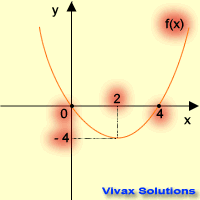
Translation
| f(x) -----> f(x+1) | f(x) -----> f(x-1) |
|---|
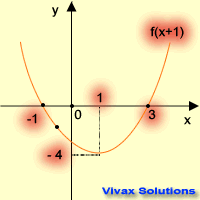 | 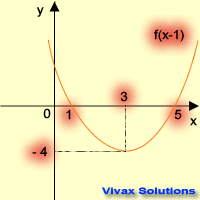 |
| translation in the -ve x-axis | translation in the +ve x-axis |
| f(x) -----> f(x) + 2 | f(x) -----> f(x) - 2 |
|---|
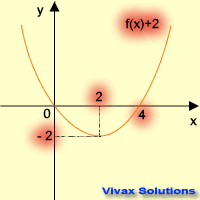 | 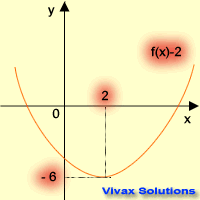 |
| translation in the +ve y-axis | translation in the -ve y-axis |
You can animate the following curves to see how translation works. Please select an option and then move the sliders.
Choose slider, a, for the translation in the x-axis.
Choose slider, c, for the translation in the y-axis.
Reflection
| f(x) -----> f(-x) | f(x) -----> -f(x) |
|---|
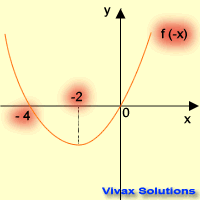 | 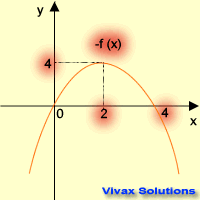 |
| reflection in the y-axis | reflection in the x-axis |
Stretching
| f(x) -----> f(2x) | f(x) -----> 2f(x) |
|---|
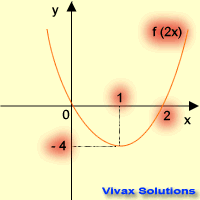 | 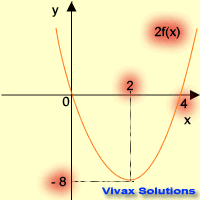 |
| stretching parallel to x-axis | stretching parallel to y-axis |
You can animate the following curves to see how stretching works. Please select an option and then move the sliders.
Choose slider, a, for the stretching parallel to y-axis.
Choose slider, c, for the stretching parallel to x-axis.
Now, let's apply the transformation to some of the well-known curves.
E.g.1
Sketch f(x) = x2 + 2x -3, and find the following:
- line of symmetry
- minimum value
- translations from f(x) = x2
- solutions
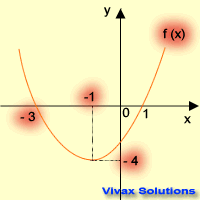
First of all, let's use the completing the square method:
Let x2 + 2x -3 = (x+a)2 +b
x2 + 2x -3 = x2 + 2ax + a2+ b
Make the coefficients of x2, x and the constant on either side equal.
2a = 2 => a = 1
a2+ b = -3 => b = -4
f(x) = (x+1)2 -4
Line of symmetry, x = 1
Minimum value = -4
This is a translation of f(x) = x2, 1 in the negative x-axis and 4 in the negative y-axis.
The solutions are, x = -3 and x = 1
E.g.2
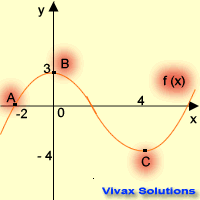
This question is based on the curve on the left; find the coordinates of A, B and C after the following
transformations. The answers are on the table.
| Transformation | New Coordinates |
|---|
| f(x+1) | A( -3 , 0 ) | B( -1 , 3 ) | C( 3 , -4 ) |
| f(x-1) + 2 | A( -1 , 2 ) | B( 1 , 5 ) | C( 5 , -2 ) |
| f(2x) | A( -1 , 0 ) | B( 0 , 3 ) | C( 2 , -4 ) |
| f(x/2) | A( -4 , 0 ) | B( 0 , 3 ) | C( 8 , -4 ) |
| 2f(x) | A( -2 , 0 ) | B( 0 , 6 ) | C( 4 , -8 ) |
| f(-x) + 1 | A( 2 , 1 ) | B( 0 , 4 ) | C( -4 , -3 ) |
| -f(x) + 2 | A( -2 , 2 ) | B( 0 , -1 ) | C( 4 , 6 ) |
Combination of Transformations
Here is an opportunity for you to practise transformations using a sine curve. The curve is in the form of
y = a + b sin(cx + d). Change the values of a, b, c and d or to see the corresponding change. This is the best form of mastering the transformations.
Now, in order to complement what you have just learnt, work out the following questions:
- Use the completing the square method to sketch f(x) = x2 + 3x -4. Then describe the transformations of f(x) = x2 to get this particular shape. Write down the
minimum value and the line of symmetry too.
- Show that the reflection in the y-axis of f(x) = x4 - 2x2 + 5 is the same as f(x).
- Write down a function that shows f(x) = -f(-x). Hence, sketch 2f(x) and f(2x) of the same function.
- If f(x) = x2 + 2x, sketch the following:
- f(-x)
- -f(x) + 2
- f(x+2) - 3
- f(2-x)
- 2f(x) + 1
- f(2x) - 3
- Sketch f(x) = x2 -x - 6 and hence sketch g(x) = (x+2)(x+3) and show that f(x+1) = g(x).
- Sketch f(x) = 1 +2 sin(x) and solve f(x) = 1.3 for 0 < x < 360. What is the minimum value and maximum value of the function?<
- Sketch f(x) = 1 + cos(3x) and hence find the period of the function, maximum value and minimum value.
- Sketch f(x) = 3 - 2sin(3x) and hence find the period of the function, maximum value and minimum value.
- Sketch f(x) = 1/x and then transform as follows:
- f(-x) + 2
- -f(x) + 2
- 2f(x) - 3
- The maximum value of f(x) = q + p cos(x) graph is 7 and the minimum is 1. find p and q.